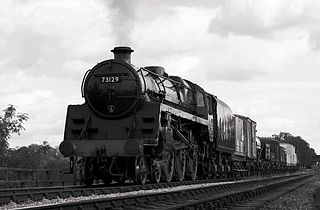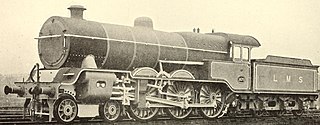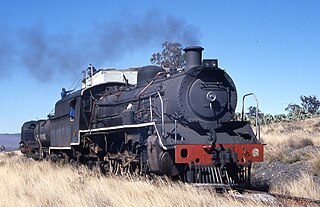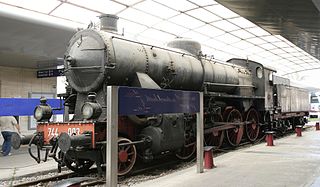
The London Midland and Scottish Railway (LMS) Jubilee Class is a class of steam locomotive designed for main line passenger work. 191 locomotives were built between 1934 and 1936. They were built concurrently with the LMS Stanier Class 5 4-6-0.

The BR Standard Class 8 was a class of 4-6-2 Pacific steam locomotive designed by Robert Riddles for use by British Railways. Only the prototype was constructed, which was named Duke of Gloucester. Constructed at Crewe Works in 1954, the Duke, as it is popularly known, was a replacement for the destroyed LMS Princess Royal Class locomotive number 46202 Princess Anne, which was involved in the Harrow and Wealdstone rail disaster of 1952.

The British Railways Class D3/7 were a class of 0-6-0 diesel electric shunting locomotives built as LMS Nos. 7080–7119. The class were built from May 1939 through to July 1942 by the London, Midland and Scottish Railway at their Derby Works using a diesel electric transmission supplied by English Electric.

The British Railways Standard Class 5MT4-6-0 was one of the 12 standard classes of steam locomotive built by British Railways in the 1950s. It was essentially a development of the LMS Stanier Class 5 4-6-0. A total of 172 were built between 1951 and 1957.

The London Midland and Scottish Railway Stanier Class 5 4-6-0, commonly known as the Black Five, is a class of 4-6-0 steam locomotives. It was introduced by William Stanier in 1934 and 842 were built between then and 1951. Several members of the class survived to the last day of steam on British Railways in 1968, and eighteen are preserved.

The Caprotti valve gear is a type of steam engine valve gear invented in the early 1920s by Italian architect and engineer Arturo Caprotti. It uses camshafts and poppet valves rather than the piston valves used in other valve gear. While basing his design on automotive valves, Caprotti made several significant departures from this design to adapt the valves for steam. Having agreed a joint-venture with Worcester-based engineering company Heenan & Froude from 1938, Heenan & Froude fully acquired Caprotti post-World War II in 1947.

The London Midland and Scottish Railway (LMS) Stanier Class 5 2-6-0 or Stanier Mogul is a class of 2-6-0 mixed traffic steam locomotive. Forty were built between October 1933 and March 1934.

The London Midland and Scottish Railway (LMS) Hughes Crab or Horwich Mogul is a class of mixed traffic 2-6-0 steam locomotive built between 1926 and 1932. They are noted for their appearance with large highly-angled cylinders to accommodate a restricted loading gauge.

The London, Midland and Scottish Railway (LMS) Class 2 Stanier 0-4-4T was a class of 10 light passenger locomotives built in 1932. Ostensibly designed under new Chief Mechanical Engineer (CME) William Stanier, they were in fact the last new design of the Midland Railway's school of engineering.

The Stephenson valve gear or Stephenson link or shifting link is a simple design of valve gear that was widely used throughout the world for all kinds of steam engines. It is named after Robert Stephenson but was invented by his employees.

The Lancashire and Yorkshire Railway Class 5 were 2-4-2T steam locomotives designed by Chief Mechanical Engineer (CME) John Aspinall and introduced from 1889 for local passenger work. Later batches included progressive modifications such as extended coal bunkers and belpaire fireboxes. The final batch built from 1911 to 1914 under George Hughes incorporating superheated boilers and belpaire firebox gave increased tractive effort, others were also rebuilt to this standard. When Hughes introduced his classification system in 1919 the more powerful superheated superheated locomotives were designated Class 6. The final examples were withdrawn in 1961.

British Railways built twenty locomotives of the LMS Stanier Black Five type, fitted with Caprotti valve gear, in 1948. These were numbered 44738-57. The LMS Stanier Black Fives had been fitted with Walschaerts valve gear as standard. In 1947, as part of an experimental programme by George Ivatt to try to improve the already good design, (4)4767 was built with Stephenson link motion. The Caprotti-fitted Black Fives were part of the same programme.

British Railways Standard Class 5 No. 73129 is a preserved British steam locomotive. It is the only surviving Standard Class 5 built by British Railways which was fitted with Caprotti valve gear.

The Lancashire and Yorkshire Railway (L&YR) class 8 was a four-cylinder 4-6-0 express passenger locomotive designed by George Hughes introduced in 1908.
The London Midland and Scottish Railway (LMS) 2 and 2A boilered 4-6-0 locomotives were express passenger 4-6-0 steam locomotives. In 1935 W.A. Stanier, Chief Mechanical Engineer of the LMS, ordered the rebuilding of the unique experimental high pressure compound locomotive 6399 Fury. The Schmidt-Henschel boiler was replaced with a tapered boiler, with a drumhead smokebox, designated type 2. The type 2 boiler had a tube surface of 1669 square feet, formed by tubes 2⅛ inches in diameter and 14' 3" long. It was fitted with a 28 row superheater with 360 square feet of heating surface. The superheater elements, 1⅛ inch in diameter, were fitted into flue tubes 5⅛ inches diameter. On test the boiler performed poorly, heat transfer to the water being inadequate because the hot gases from the firebox passed too rapidly through the tubes to the smokebox. The rapid passage of gas was indicated by too high a temperature in the smokebox, and the choking of the smokebox by excessive char carried through from the firebox. The boiler was re-tubed with 180 smaller tubes 1⅞ inches diameter, and with superheater elements 1¼ inch diameter. The single blastpipe was replaced with a double blastpipe and chimney to provide adequate gas velocity in the smokebox. This, combined with the increased rate of evaporation provided by the re-tubing, improved the performance of the boiler substantially.
The Lancashire and Yorkshire Railway (L&YR) operated two classes of twenty steam railmotors in total.

The South African Railways Class 19B 4-8-2 of 1930 was a steam locomotive.
Southport MPD is a former LMS railway depot located in the town of Southport, Merseyside.

A double chimney is a form of chimney for a steam locomotive, where the conventional single opening is duplicated, together with the blastpipe beneath it. Although the internal openings form two circles, the outside appearance is as a single elongated oval.

The Ferrovie dello Stato Class 744 is a class of 2-8-0 steam locomotives; they were the last orthodox steam locomotives built for the FS.

















